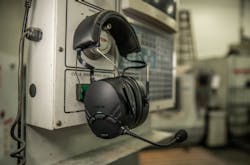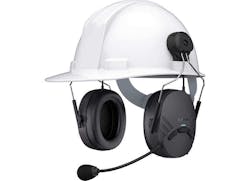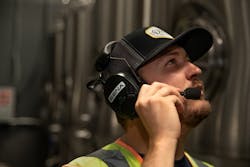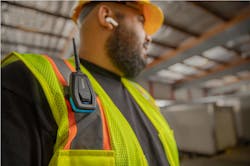Going Digital: New Communication Tools Are Replacing Two-Way Radios
In the last three or four decades, manufacturing has changed dramatically. Gone are the days of manual inventories and fax machines—replaced in favor of automation and software to enhance efficiency and productivity. So why do so many manufacturers still use analog two-way radios? In the 80s and 90s, many industries adopted the technology of that age and the two-way radio was a great solution for worksites that were spread out, have noisy environments, and depend on person-to-person and group communication for productivity. However, advances in digital technology have managers considering modern communication technology options for their wireless networks and enhanced safety. New digital communication systems use the Bluetooth frequency around 2.4 GHz and include high-definition sound, noise-canceling technology, multiple channels, optional hearing protection, and hands-free operation.
A Review of Communications Technology
Two-way radios use half-duplex technology meaning that each person has to push a button to talk and to respond in a conversation, while others wait for their turns to speak. Due to the back and forth nature, conversations can take anywhere from two to five times longer than a natural conversation. In addition, two-way radios require hands-on use, so workers frequently have to stop what they're doing to communicate. This can hurt worker output and, in some cases, can decrease worker safety.
Some plants have attempted to modernize by using mobile phones, whether provided by the company or as part of the bring-your-own-device movement. While workers are comfortable using this technology, it suffers some of the same drawbacks as two-way radios. Phones require a hands-on operation, and texting is slow and similar to a half-duplex conversation. Also, this strategy relies on consumer devices that are not ruggedized for industrial environments, consume battery power quickly, and dependable cellular coverage for all areas.
What is Bluetooth Intercom Communication?
The word “Bluetooth” may conjure thoughts of wireless mice and smartphone earbuds. Actually, the technology used by Bluetooth intercom headsets is a longer range and more powerful than the Bluetooth technology used by consumer-grade accessories. Bluetooth Intercom uses a specific profile to connect headsets together for voice communication.
Setting up a Bluetooth Intercom system is as simple as pairing devices to each other, like pairing a cell phone to a car. Typically, a network is limited to four devices. It is secure in that each device in the network must accept the other. This security feature is not available with two-way radios, which transmit over a public band. Bluetooth does not rely on wi-fi, so no IT involvement is required. With Bluetooth headsets, such as those from Sena Industrial (fig. 1), the range is typically 0.5 to 0.8 miles in the open air. Inside buildings, the range is less, but it is generally adequate for manufacturing facilities. The battery life is typically 10 to 15 hours, much longer than with a mobile phone.
Learn more about Sena Technologies' Tufftalk Lite headset.
What is Mesh Intercom Technology?
New mesh headsets, such as those using Sena's proprietary Mesh Intercom protocol (fig. 2), use a topology of nodes that link to each other to efficiently route data or signals. Each device on the network acts as a node, extending the network and making the signal stronger. This principle is the same used by other industrial mesh networks such as sensors and wireless data devices.
A Mesh system offers benefits beyond a simple Bluetooth Intercom system. Because each headset acts as a repeater, the range can be extended over longer distances. Mesh also allows a virtually limitless number of headsets, enabling their use for large and multiple work teams. The network is self-healing: if a worker leaves the coverage area, as soon as they return, the headset automatically reconnects to the network. The range between two Sena Mesh devices is 0.7 miles in the open air, but the presence of additional devices will greatly expand the coverage area. The battery life is typically around 13 hours.
The Impact of Digital Communication on Productivity
Headsets that use Bluetooth and Mesh Intercom systems are full-duplex devices. This means every person can talk and listen at the same time, similar to a phone call. This allows for the ability to interrupt a coworker in order to clarify what is being said, reducing the risk of errors that could arise from miscommunication. Just as important, full-duplex allows for hands-free operation because there is no requirement to press a button to talk. The lightweight headsets let workers keep their hands-on tasks and simply speak to team members without stopping work.
Bluetooth and Mesh headsets provide high-definition sound that aids understanding and avoids miscommunication that may lead to delays or mistakes. Radios, on the other hand, have pops, crackles, and other sound quality issues related to analog signals, including interference and chatter from radios outside of the network.
A Connected Workplace Made Simple
To minimize the distraction, different works teams may be assigned different radio channels. This means that some plant managers must wear multiple radios on their belt in order to stay in touch with all teams. A Mesh Intercom system, in contrast, simplifies the hardware needed by offering multiple communication channels in a single device. Plant managers and foremen can communicate with all work teams via their headsets, which also reduces the noise that accompanies multiple radios.
Unlike two-way radios and mobile phones, Mesh Intercom systems can be integrated with plant equipment. As part of IoT initiatives, some plants have Bluetooth-enabled PLCs. With the help of an optional adapter, audible alerts with spoken recordings can be received by workers on their headsets, such as a notice that a hopper is empty or that a machine needs maintenance. This accelerates attention to issues and reduces plant downtime.
Some workers will want to use their own earbuds instead of a Bluetooth or Mesh headset. Adapters (fig. 3) are available that connect any Bluetooth-enabled headset or earbuds, including Apple AirPods and Google Pixel buds, to the network. This works well for temporary contractors using their own gear.
Learn more about Sena's MeshPort Blue adapter.
Going Digital for Safety
Every year, 22 million people are exposed to damaging levels of noise in the workplace, according to OSHA. Employers tend to be good about providing hearing protection, nevertheless, its adoption by workers may be spotty. One cause is that it is difficult to communicate while wearing earplugs. Often workers must stop their task in order to use sign language, or workers must move close to the other person in the conversation so they can be heard, perhaps by shouting. Communication headsets with integrated hearing protection protect workers while enabling them to communicate clearly in noisy environments without any need for them to remove their PPE.
By using communication headsets having integrated hearing protection, employers can protect worker hearing and improve productivity at the same time. Worksites are also safer when communication is clear and immediate. Warning a coworker of impending danger from a machine or forklift should not have to wait for the worker to push the talk button on the radio and for the coworker to decipher what was said.
For improved safety and productivity gains, plant and maintenance managers are switching to new digital communication tools. Two-way radios will always have a role in some applications, but modern digital Bluetooth and Mesh Intercom headsets are a sound investment.
About the Author
Chris Clarke is an Industrial Communications Consultant at Sena Industrial. Sena offers Bluetooth- and Mesh-enabled headsets and communications solutions for a host of industrial and outdoor worksite environments. To learn more about Sena communication solutions, visit senaindustrial.com.



